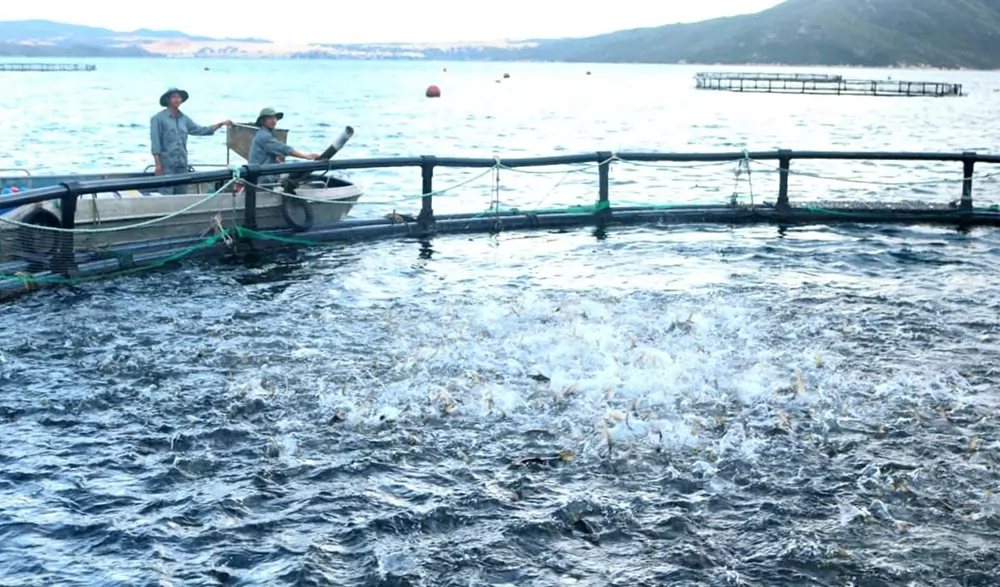University lecturer successfully restores Cổ Lũng duck breed

Cổ Lũng duck is making a comeback, thanks to the hard work of Trương Thanh Hải. — VNA/VNS Photo
THANH HÓA — A university lecturer was so impressed with the famous Cổ Lũng duck dish of Thanh Hóa Province that he invested his own money into studying and restoring the breed.
Cổ Lũng duck is a speciality breed of Cổ Lũng Commune, Bá Thước District but it is only raised by local people on small farms. The breed is also highly hybridised, and so is facing the risk of extinction.
Trương Thanh Hải, a lecturer at the Aquaculture Department of Thanh Hóa-based Hồng Đức University, said that the droop-necked, short-legged duck was well-known for its tasty meat that is not greasy or foul-smelling like duck from other regions.
In the early 2000s, Hải went to the duck-rasing area in Bá Thước District to learn about the duck breed. Through research, he found that the Cổ Lũng duck was crossed with the Bầu Đất, white-winged and super-egg duck, with a hybridisation rate of over 60 per cent.
Realising that the Lũng Cú duck species' genetic resources could be recovered, he decided to bring it back for breeding and crossbreed purebreds with the ratio of one male to five females, Hải said.
Producing purebreds and providing breeds to the market, in March 2016, Hải decided to invest more than VNĐ1 billion (US43,740) to rent nearly 4,000sq.m of land in Quảng Thành Ward, Thanh Hóa City, to open a Cổ Lũng duck breeding farm.
Starting with 120 original-breeding Cổ Lũng ducks, after seven years of researching and breeding, Hải is now the owner of a duck farm with tens of thousands of purebred ducks.
The purebreds of Hải have a uniform colour of 95–97 per cent, a large, short neck, and short legs. The males have blue heads while the females' are brown. The ducks have better resistance than the old original duck breed, weighing 1.8kg per head, 0.5kg heavier when compared to the old duck breed.
Each year, Hải sells about 8,000 ducks for meat at the market price of VNĐ80,000-95,000 per kg. He also supplies 8,000-10,000 breeding ducks to the market each year, with the price of VNĐ13,000-15,000 per head.
Sharing about the technique of taking care of purebred ducks, Hải said that the stage of choosing eggs for reproduction was extremely important.
When the eggs are hatched, only the ducks that have their umbilical cord not to be seen and those that are not sick are selected for breeding.
After the ducks are one week old, the ducks are fed with fine bran with protein accounting for 25 per cent. Then, when the ducks are two months old and more, they are fed with bran pellets.
From the third month, ducks are fed with feed containing 30 per cent corn, 30 per cent rice, and bran. From the fourth month, Hải switches to feeding the ducks with a diet containing 40 per cent corn, 40 per cent rice, 20 per cent fish, then pureed, fermented, and combined with green vegetables to reduce fat.
“With this diet, the duck meat is more fragrant and their weight is kept at the average of 1.8-2.2kg per male duck, and 1.6kg per female duck.
Every year, minus expenses, Hải earns about VNĐ300-400 million from raising Cổ Lũng ducks.
Đỗ Thị Trang, chairwoman of the People's Committee of Quảng Thành Ward, Thanh Hóa City, said that the locality highly appreciated the economic efficiency brought by the duck farm model of Hải.
“The locality would create favourable conditions for Hải’s family to access preferential loans to develop and expand the model,” she said.
When the ward authority organised training courses on husbandry and farming, Hải was invited to share his experiences and encourage people to follow him, she said.
Now, Cỗ Lũng ducks are not only raised in Bá Thước but also other districts such as Quan Sơn, Vĩnh Lộc, Thạch Thành, Hoằng Hóa or Quảng Thành Ward.
When providing the duck breeding, Hải also instructs how to care for and vaccinate ducks.
In addition to the livestock farm in Quảng Thành Ward, Hải said that he also rented land to open farms in Triệu Sơn and Thạch Thành districts to raise livestock and grow bananas and corn as a source of food for livestock. — VNS
Maybe you are interested

First breeding shrimp farm in Vietnam meets OIE standards
A breeding shrimp farm of the Viet-Uc Seafood Corporation in the Mekong Delta province of Bac Lieu has become the first in Vietnam to fulfill criterion set by the World Organisation for Animal Health (OIE).

High-tech mariculture: unlocking potential, overcoming challenges
Khanh Hoa Province is rapidly transitioning to high-tech marine aquaculture to adapt to climate change and enhance the value and output of its seafood.

Farmer raises Japanese koi in saline water
Many farmers in Bình Chánh District of HCM City have switched to raising ornamental Japanese koi fish in saline water in recent years.





